Brief • 4 min Read
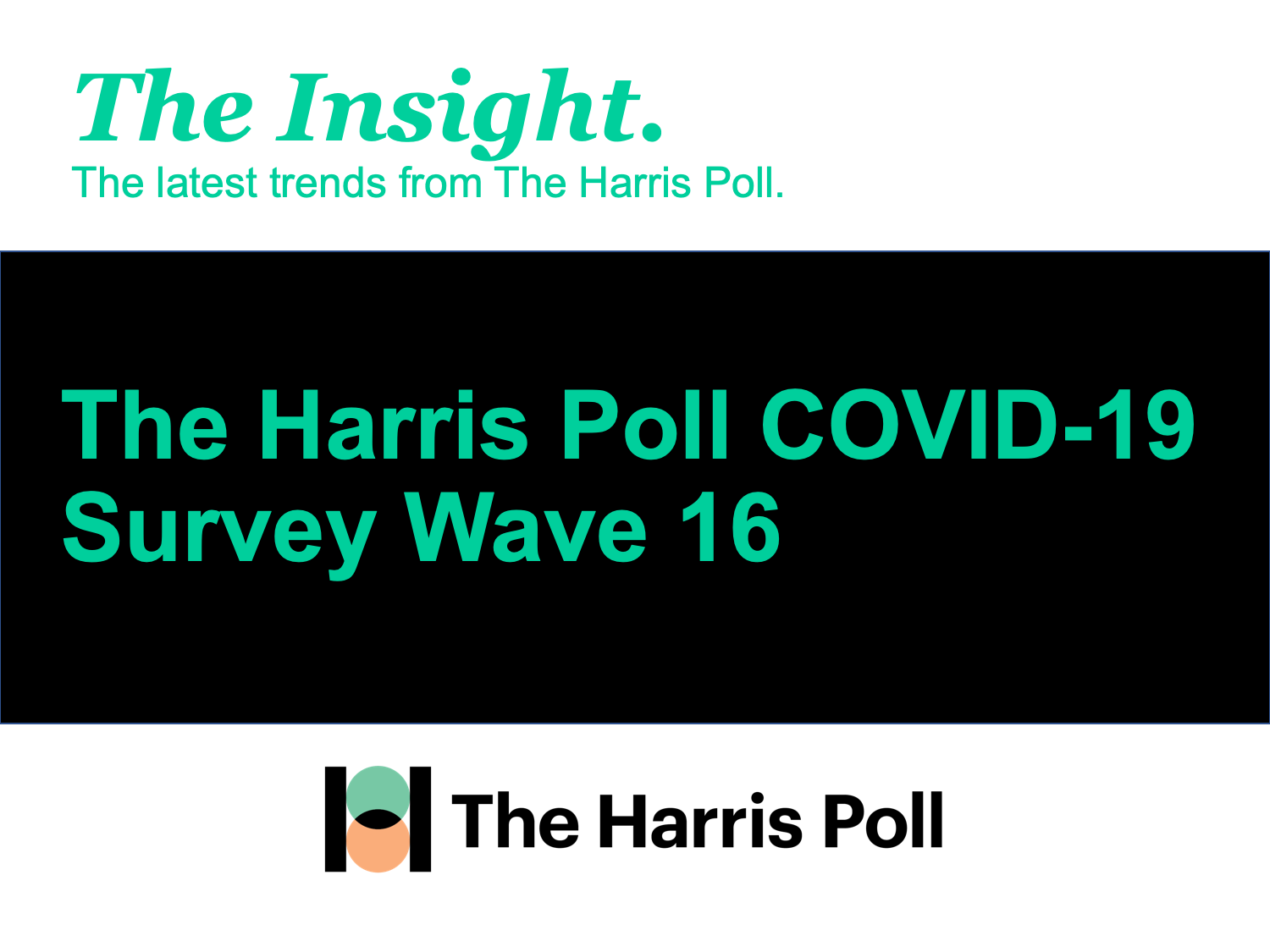
In Wave 16 of The Harris Poll Cv19, Tracker fielded June 13 and 14, 2020, Americans begin to unify around football and an ad featuring the NFL’s most famous unemployed quarterback. We also share the release of The Essential 100, our ranking of corporations whom Americans feel have risen up to fight the pandemic.
Getting to a full re-opening has been challenging as COVID cases rise in many parts of the U.S. We’ll look at suggestions for how companies and brands should act.
Lastly, the technology industry has enjoyed a surprising rise in credibility during COVID. But as the election approaches will that last? We explore the tech-lash-lash and how companies might align themselves amid Black Lives Matter, Cv19, and the coming election.
As a public service, our team has curated key insights to help leaders navigate Cv19. Full survey results, tables, and weekly summaries can be accessed for free at The Harris Poll Cv19 Portal. We will continue to actively field on a regular cadence to track the shifts in sentiment and behaviors as the news and guidelines evolve.
Believe in Something…Even if It Means Sacrificing Everything
The markings of social change lie in symbols and iconography, like a toppled statue, a protest song or even an ad. We had polled America’s reaction to Nike’s Colin Kaerpnick ad in 2018 and re-tested it this past weekend. And American opinions have shifted to support Kaepernick, Nike, and the NFL’s new stance on racism:
- Back when we polled Americans with ESPN, we found significant polarization on the ad with young men connecting, while the general public was neutral to negative and even threatening to boycott.
- Now in a new Harris Poll with The Athletic released Monday (firewall – see full article here) shows that two years on, negative impressions of Nike have been cut in half: from (17%) in 2018 to just (9%) in 2020.
- Also Nike Boycotters are disappearing, especially older and conservative Americans. In 2018, (21%) said they would either boycott or just stop buying Nike products — now that number has dropped to (14%) today. And the biggest movers are Seniors 65+ (from 34% ‘boycott/don’t buy’ down to 18%) and Conservatives (from 41% ‘boycott/don’t buy’ down to 24%).
- And of the three major athletic apparel brands, Nike is the only one to see a strengthening of its reputation this past weekend since the Kaepernick ad campaign . Today, (54%) of the general population have a positive opinion of Nike in our new survey, up 6-pts from (48%) in September 2018. Under Armour is down 8-pts to (40%); Adidas: down 1-pt to (51%).
- Also, Nike’s perception is soaring among young men: in 2018, (54%) of men 18-29 had a positive impression of Nike. Today, that’s jumped up to (66%) of young men viewing Nike positively.
- The NFL is doing better too: As our NFL data, featured in Axios this morning, shows, in 2018 only (25%) of Americans thought that the NFL’s response to national anthem protests was positive. In 2020, this increased, up to (32%) in light of the ongoing movement.
- Also, good marks for Roger Goodell: In the new 2020 survey, America feels the NFL is taking meaningful steps with 3 in 4 people (73%) pleased with the action Goodell has taken. Among them: (69%) support his statement condemning racism and oppression. Only (31%) opposed the statement. Furthermore, (73%) say it is a step in the right direction and (68%) say it shows that the NFL is making meaningful action to evaluate their role in racism.
- We also asked people to agree or disagree with a number of statements (mutually exclusive). Among them, (66%) agree it felt insincere “they are just doing it for publicity”, yet a near equal number (64%) say NFL carries the greatest burden of any sports league to rectify the damage it now admits it has done.
- One piece of public advice? (61%) say Roger Goodell should offer Colin Kaepernick an apology.
Takeaway: In 2018, Nike’s Colin Kaepernick ad was framed in a narrative of division and disrespect. But now it increasingly symbolizes unity and inclusion. Seeing the public (and the NFL) soften on Kaepernick is the start of a conversation, the kind that is happening all across America.
The Essential 100
On Friday we launched The Essential 100, a ranking of corporate performance amid the Cv19 pandemic. The Top 10, based on the survey, are (in order): United States Postal Service, Clorox, Google, United Parcel Service, Walmart, Amazon, Purell, Microsoft, FedEx, and CVS.
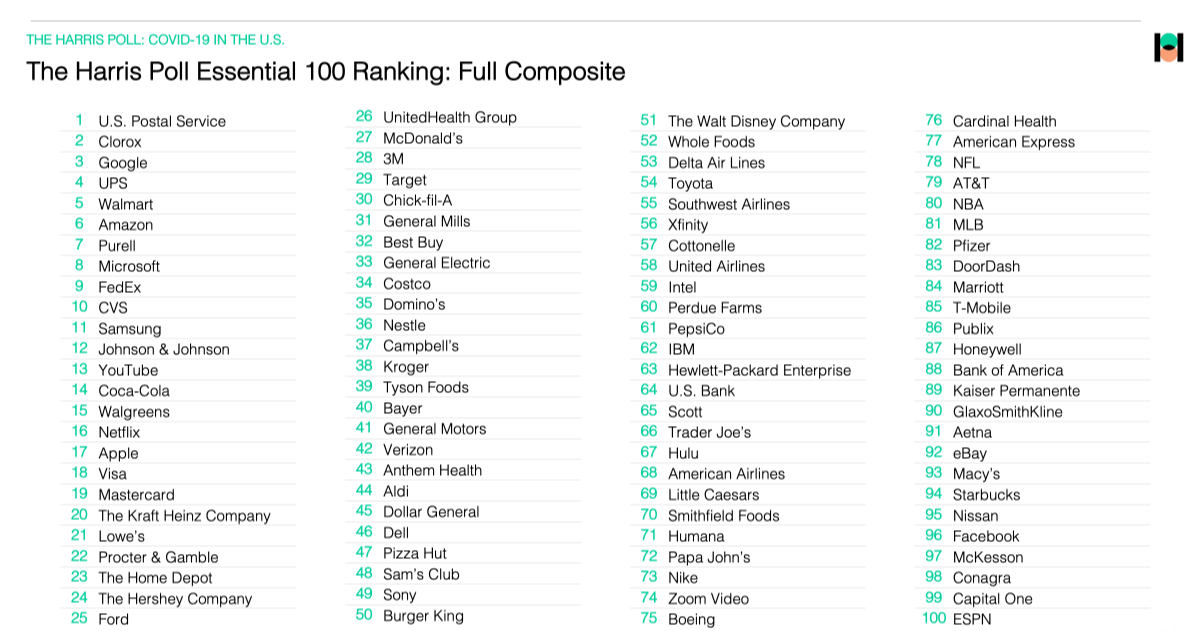
- This ranking which was featured in Alan Murray’s CEO Daily on Monday measures corporate responsiveness, trust, integral and lasting ability to find solutions to the pandemic. The major themes underlying corporate reputation right now include America’s preference for large logistics-driven, resourced, and innovative companies because they represent safety, reliability, and proven performance. Logistics meant things kept working in daily life, despite COVID and the economic shutdown.
- For instance, many of the top performing companies were visible throughout the crisis (delivery services) or pivoting to different goods and services, reinforcing supply chains, or seeking cures for the deadly virus.
- The other thing: Many reputation studies cite the erosion of trust in Corporate America. We see exactly the opposite. This chart shows how corporate reputation is rising across all industries, even pharma, financial services, and tech.
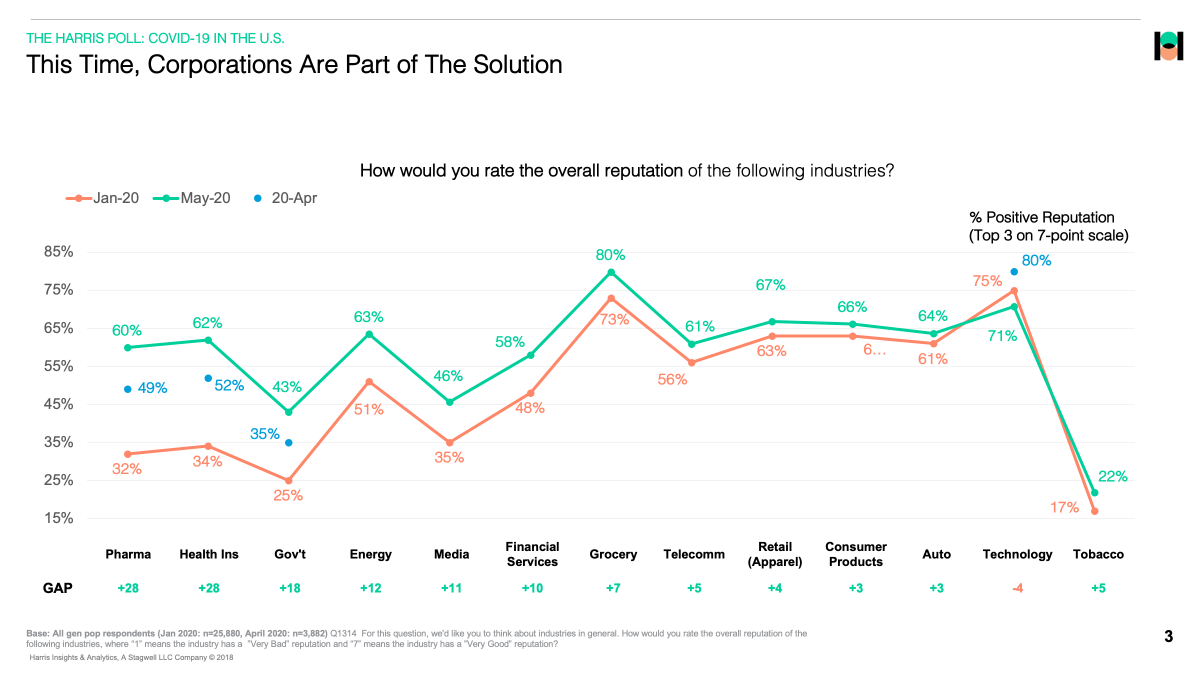
- You can download the full deck here.
Takeaway: In the global financial crisis, Corporate America was part of the problem. Now, they are part of the solution. Reputations are being remade during these unprecedented challenges, even industries that held longstanding headwinds like pharma and financial services. We will have a new Axios-Harris Poll 100 study of corporate reputation coming out in late July.
How To Respond In the Age of Unrest
We are living through a moment in history. One marked by social unrest amidst an unprecedented fifty-state closure with activists in the streets of America calling out for racial equality. Here we look at the number of social and economic obstacles society face and the role that companies and brands can play in guiding America forward.
- Let’s start with the number one obstacle to a full re-opening, which is the virus itself. As of this weekend, Cv19 cases are climbing in twenty-two states resulting in (79%) of Americans this weekend saying they fear a second wave of coronavirus.
- In an Axios poll yesterday, 8 in 10 Americans say they are concerned about a second wave of the coronavirus, with large majorities saying they’ll resume social distancing, dial back shopping and keep their kids out of school if it happens. In our data, (70%) feel the fear around Cv19 is justified.
- But people are beginning to venture out, reflected in a drop of those fearful to leave their house for essential errands at (73%) this week, which was in the eighties as of two weeks ago. Still, Americans face the twin fears of dying (53%) or losing their jobs (50%).
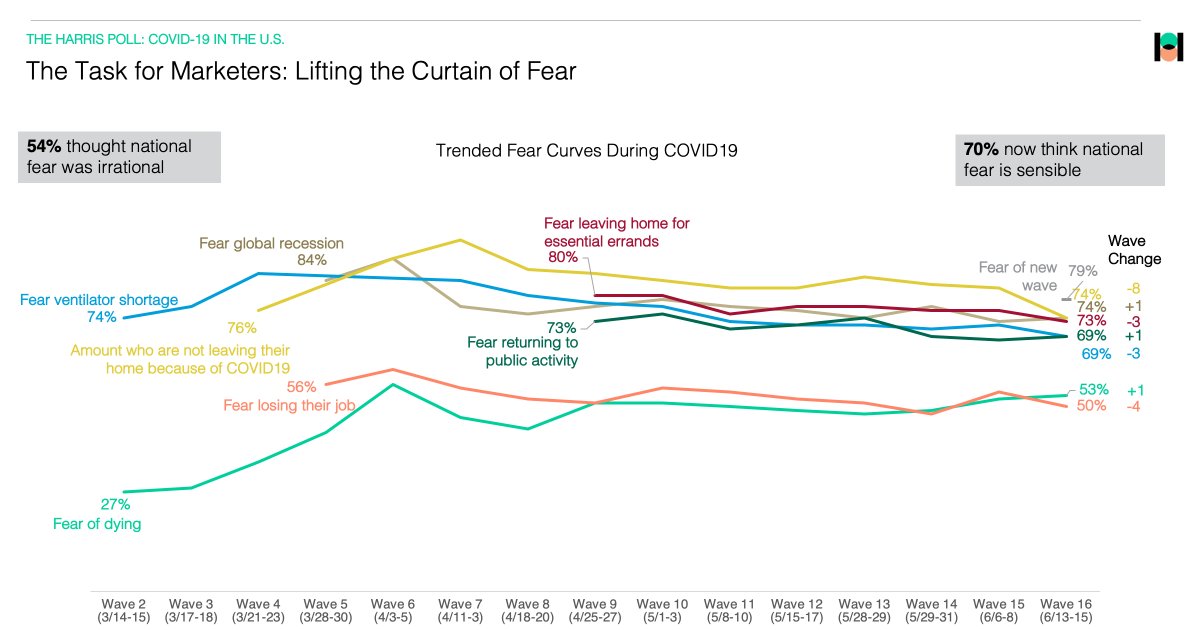
- American patience is also on the wane. While more than three quarters (77%) say their state has partially reopened, a fewer number (59%) support their state’s approach to re-opening. In fact, more than 2 in 5 (41%) oppose their state’s approach to re-opening, especially in the South (46%). While more than three quarters of Americans (77%) think the lockdowns were effective in their area, a fifth think they were not (20%). Gen Z/Millennials are more likely than Senior to think the lockdowns were not effective (28% vs. 16%), or to say they are not concerned about a new wave of COVID-19 outbreak in their area (26% vs. 17%).
- Women are more cautious than men and are more likely to say they plan on continuing to wear PPE in public (46% vs. 39%) and plan on continuing to save more and spend less (53% vs.41%) in the long term.
- At the same time, the nation is coming face-to-face with a parallel wave of social unrest driven by racial injustice, and Corporate America is now pledging to play a bigger role. Some are being pushed by employees or by a fear of losing customers. The issues companies are wrestling with range from inequalities in hiring, pay and promotion, fostering toxic workplace cultures and consumer discrimination, among others.
- In our new Harris Poll, Americans feel their spending power can bring about change. More than 3 in 5 Americans (63%) say they are more likely to buy from companies and brands that contribute to organizations/causes that combat racism while over two-thirds (67%) say companies/brands should ensure businesses/clients they do business with share similar standards when it comes to combating racial inequality. Women are more likely than men to say this (70% vs. 63%) as are Black People (73% vs. 65%).
- And a third of Americans (32%) believe companies/brands have not done enough to increase diversity in their leadership while (57%) say they should respond publicly to protests and rising racial tensions.
Takeaway: How do you respond in an age of anxiety? Carefully and confidently: Right now, Americans want authenticity and action, 74% think companies should speak out on Cv19 and 57% say companies should incorporate their views into advertising. Americans also want inclusion, 88% say racial equality is an important issue to them personally. But corporate values must be reflected on the inside first and shared in a meaningful way, as 26% say companies advertising during Cv19 are just doing it for publicity. For Corporate America, responding in this day and age is not about what you say, it’s about what you do.
Tech lash-lash
Since the outset of the pandemic, the technology sector has received a strong and consistent approval in their Cv19 response, with (55%) of Americans saying technology has had a good reaction to the pandemic. But the backlash on the use of facial recognition by law enforcement and the act of censoring (or not) misleading information is but one litmus test for tech’s promoting of civil rights.
- Americans will give up privacy to fight Cv19: More than 3 in 5 Americans (61%) are willing to share their contact information with the government and (81%) support using their data to help trace coronavirus cases. In fact, fighting Cv19 has become part of American patriotism: (85%) say Americans have a responsibility to each other to take preventative measures to limit the spread of Cv19.
- But, there is a new backlash on facial recognition technology amid the fight for racial equality: Just this week Senators voiced concern for the technology being used on BLM protesters, citing misuse during the 2015 protests in Baltimore following the death of Freddie Gray in police custody, where law enforcement used facial recognition to identify Facebook profiles and target arrests for outstanding warrants.
- Tech is now pivoting to support equality and civil rights: Just this week, IBM announced it will stop developing facial recognition technology, Amazon announced a one-year pause on letting police departments use its facial recognition tool, and Microsoft banned the sale of facial recognition technology to police without federal regulation. Washington Post deep dives into how Black Lives Matter could change facial recognition forever — if Big Tech doesn’t stand in the way.
- Meanwhile, social media faces backlash on transparency: While there is growing support for tech in the pandemic, our data reveals growing skepticism of social media platforms; only a third (36%) say social media platforms are trustworthy while the majority of Americans (53%) say the information in their social media news feeds is mostly misleading.
- Early signs of social media political delineation: After Twitter labeled the Presidents’ tweets with a fact check, we asked if people think social media platforms should or should not censor information they believe to be false/ misleading and (70%) of Democrats say that social media companies should censor information they believe to be false/ misleading, while only (57%) of Republicans agreed.
- Scott Galloway has a very interesting take on how social media brands like Twitter and Facebook might start to align along political division.
Takeaway: Hey tech don’t blow this moment! Americans see technology as critical to solving Cv19, fighting racism and being essential to our everyday lives––especially while sheltered at home. But the industry seems to be drawing lines on ethics between those relying on advertising revenue vs. subscription; the latter being more ethical because they don’t have to monetize rage and division for profits. Why can’t everything have a paywall?
The Telehealth Revolution is Here
Although states have begun to lift stay-at-home restrictions, Americans remain cautious and seek to minimize unnecessary social contact. Before the coronavirus pandemic, Americans were slow to pick up on the telehealth trend. Yet according to analysts at Forrester Research, social distancing measures at doctor’s offices and hospitals could push virtual care visits to the 1 billion mark by the end of 2020. In an effort to dive deeper and understand the future of healthcare, The Harris Poll has tracked the significant rise in demand for telehealth services across different applications and demographics.
- After the first six weeks of lockdown, only (32%) of Americans had used telehealth services; less than a month later, we see a significant jump in demand to (44%). And among those users (70%) claim they used it for the first time during the pandemic.
- Since the end of April, new users of telehealth have increased from (15%) to (27%) and is consistent across demographic groups. Usage is also up among men from (37%) to (50%). Additionally, younger adults are still more likely to have used telehealth than older people yet there is a notable increase in usage among Americans 65+ during this time frame from (18%) to (28%).
- Over half of Americans are still reluctant to engage in a traditional health care setting (for non-emergency visits) unless specific conditions are met and nearly two in ten (18%) say they wouldn’t go to a doctor’s office for elective healthcare under any circumstances. As such, it’s no surprise that telehealth utilization rates are increasing not only overall, but also in frequency of use. And since the pandemic began, nearly four in ten (37%) have used telehealth services three or more times.
- Overall, telehealth continues to be used for a diverse set of applications including mental health services, diagnostic visits (for non-Cv19 and Cv19-related conditions), nutritional consultations and physical/occupational therapy sessions. There has been an increase in ongoing management of existing chronic conditions and remote monitoring of chronic health, as well as a particularly notable uptick among those in the 65+ age group for using telehealth for ongoing management. (Wave 1: 58% versus 64% in Wave 2).
Takeaway: As in our initial wave, nearly eight in ten (79%) of those who have used telehealth indicate that they are likely to continue doing so after the pandemic subsides – with (40%) of users say “very likely”. While the data is positive across many aspects of telehealth services, there is one variable that emerges as a key driver of Americans’ willingness to keep using telehealth services – and that is that it’s simply effective. When examining the data via regression analysis, the fact that telehealth is able to ‘effectively address my health concerns’ carries twice the impact of most of the other items evaluated. In response to this demand, politicians and business leaders need to jointly decide on the future policies regarding technology and reimbursement for telehealth services, particularly among employer-based plans.
Subscribe for more Insights
Subscribe to our newsletter for the latest trends in business, politics, culture, and more.
Download the Data
This survey was conducted online within the U.S. by The Harris Poll from June 13 to 16 among a nationally representative sample of 1,963 U.S. adults.
Download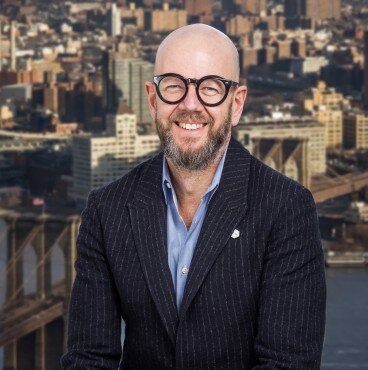
Subscribe for more Insights
Subscribe to our newsletter for the latest trends in business, politics, culture, and more.
Download the Data
This survey was conducted online within the U.S. by The Harris Poll from June 13 to 16 among a nationally representative sample of 1,963 U.S. adults.
DownloadRelated Content








